LID and Stormwater Presentations
The SSEA and its partner municipalities obtained funding from the Federation of Canadian Municipalities in the Fall of 2007 to develop a community‐based Sustainability Plan. A Steering Committee was formed, along with a community based Sustainability Advisory Team to develop the plan. SSEA also attended at a number of community fairs and formed a Citizen Panel. With this input, and support of municipal councils, the Plan’s draft was completed in December of 2008. Based on the success of the Remedial Action Plan, and the Picture This! Our Plan for a Healthy Community processes, the Plan includes a Vision, Goals, Strategic Directions and Actions that will, when implemented, ensure the sustainability of the watershed for generations to come.
Presentation #1
The Business Imperative of Climate Change Adaptation for Municipalities - Intact Centre
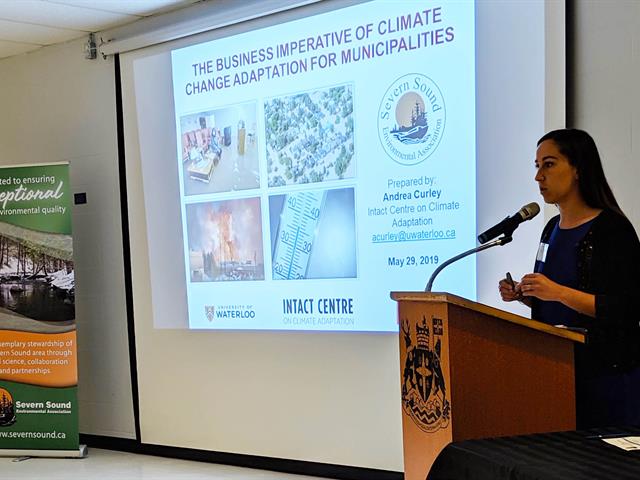
Yes, in reports online
It was adjusted for those
Key Messages:
- Water is a huge ongoing problem to be addressed, guidelines & standards are a way to achieve results
- 50% of insurance payouts are due to water/flooding. The increase in storms/payouts is at a great expense to homeowners, both economically and mentally
- Catastrophic insurable losses (event that is $25 million or more) are increasing
- in 1980s, average insurable losses $500 million, over $1 billion now
- 50% of insurance payout related to water
- for every $1 insurance payout, $3-4 individual/government cost
- flooding becoming a chronic problem –some areas not eligible for flood insurance anymore, or homeowners can’t afford, or cap limit is low
- average payout for flooded basement is $10K, but actual cost is ~$40K
- household might be able to handle first flood, but after 2-3 events, cost is unmanageable
- flooding impact on mental health, stress –average person took 7 days off work to deal with flood, still feel stress when it rains/floods in case they are impacted again
- Intact Reports: home level flood protection guide, new community design (becoming a national standard), existing community retrofits (becoming a national standard), commercial real estate retrofits
- benefit from following standards for homeowners –can get 5-15% decrease in premiums
- partnering with colleges, home inspectors to communicate flood resilience practices to new buyers
- partnered with insurance brokers to communicate practices to existing homeowners
- also partnered with Red Cross volunteer training on flood risk –pilot in 2 towns; findings being released within the next year
- important role of green infrastructure in mitigating flood risk
- Waterloo, Mississauga case studies (in report: Combatting Canada’s Rising Flood Costs)
- effect of presence or absence of wetlands: more than $50 million savings with presence of wetland
- cost/benefit analysis of grey vs. green infrastructure
Presentation #2
Stormwater Management - What’s All the Fuss About! - LSRCA
Notes:
- optimization of grey/green infrastructure
- history of stormwater (SW) management
- no SWM really prior to 1980s, direct discharge
- early 1980s, quantity control, slow release, rapid conveyance to receiver or facility
- 1990s, quantity and quality control, rapid conveyance to wet pond
- now dealing with legacy of old infrastructure, many areas without stormwater (SW) control
- high phosphorus (P) loads in SW
- diverting SW to ponds reduces groundwater recharge, reduce cold water fish habitat
- Stormwater Management Ponds (SWMPs) become P source not sink –low dissolved oxygen causes P release from sediment in highly bioavailable form
- 1 in 100 year events now happening 1 in 10 years, very localized (e.g., storms in Newmarket, but not in Barrie)
- SWMPs not being maintained as they should –regular dredging required, usually contaminated sediment
- in Lake Simcoe, ~1 tonne of P could be removed if ponds maintained properly
- problem will get worse with growth and climate change
- increasing storm frequency, increasing base flow, increasing winter flow
- SW planning is based on municipal boundaries, not watersheds which would optimize environmental outcomes
- working on SW modelling on watershed scale –results later this year
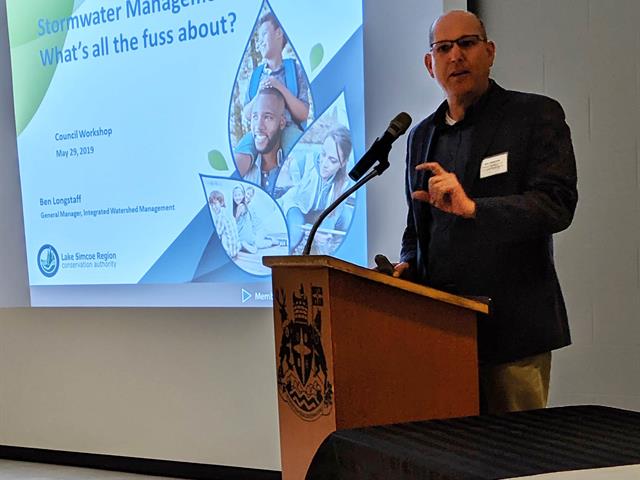
Presentation #3
Shifting the Stormwater Paradigm - the Lake Simcoe Situation - LSRCA
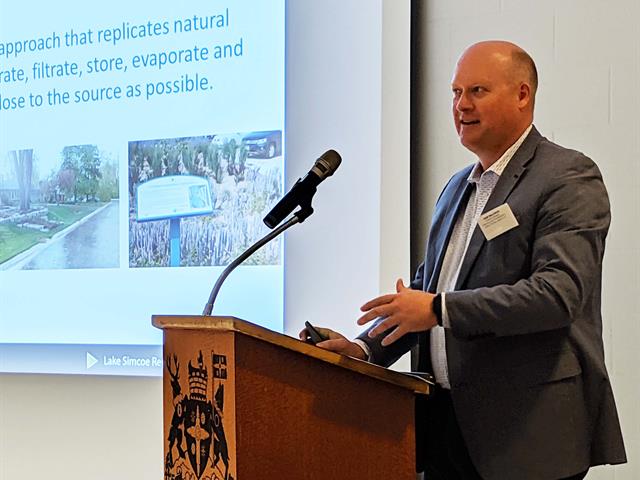
Target is municipality where offset $$ are generated, but trying to make it more watershed based (where is best bang for buck? might be upstream but outside municipality, but will benefit municipality during storm events)
Key Message:
“Fight for minimums, partner for maximums” – Partnerships are key
LID – hybrid between grey/green infrastructure, replicates natural features to infiltrate, filtrate, store SW e.g., permeable pavers, bioswales, rain gardens, downspout disconnection, green roofs, rainwater collection
in Lake Simcoe watershed, have approximately 250 ponds
- retrofit to make them function better, e.g., put in downstream wetland
- LID reduces P loading, decreases flooding, decreases sewer surcharge events, wastewater treatment plant bypasses
- How to get better site designs?
- capture first flush onsite (first 25mm) –that’s where the nutrients are
- allow buffers, municipal parks to be used for LID, use setbacks between developed land and protected features (wetland, forest) for LID
- pre-application charrettes –with developer, designer, planning team, engineers, parks –helps with approval process
- Lake Simcoe Phosphorus Offsetting Program (LSPOP)
- provide learning and reference resources, webinars, factsheets
- LID treatment train tool
- Wiki LID planning and design guideline
- cost: LID vs traditional wet ponds – LID cost can be higher upfront, but cheaper maintenance and get more developable land
- transfer of Environmental Compliance Approval review duties to LSRCA (reduced approval times)
- water budget – post-development must match pre-development
- upcoming work in LSRCA – SWM optimization modelling, performance monitoring, SWM facility database, research/development projects
- funds from 3 offsetting projects –Phosphorus Offsetting Program, Ecological Offsetting Plan (non-significant loss of woodlots or wetland), Water Balance Offsetting Program
Presentation #4
Making Progress: A Municipal Perspective - Town of Newmarket
Key Messages:
- Municipalities have no choice, have to take action now – due diligence for managing stormwater is required
- Municipalities are at risk of liability
- need places for intense storms to drain
- “sponge cities” China, Europe
- biggest risk from climate change is flooding
- municipal liability –class action lawsuits
- (Muskoka $900M (dropped), Thunder Bay $300M (negotiations continue), Stratford settled for $7.7M, had to implement $70M in retrofits)
- can’t be negligent to climate change risk if showing due diligence, can avoid liability
- Newmarket paradigm shift (repetition is key):
- standing item on LID at council
- always LID before traditional SWM
- seek partners (LSRCA, Ministry of Environment Conservation and Parks (MECP), Federation of Canadian Municipalities, regional government, Natural Resources Canada, Environment and Climate Change Canada)
- capitalize on all opportunities: development (policies and bylaws), capital, transportation (LID with traffic calming), residential retrofit, lead by example on municipal lands
- municipal stormwater fee –separated it on tax bill, first year net 0, after that 12% increase per year for next 12 years
- created Sr Climate Change Specialist position
- open to macro-economic watershed approach across borders (e.g., Newmarket might contribute to work in Aurora)
- hosted council workshop –communicated risk
- case study: Forest Glen rd – no storm sewers, all LID (YouTube video available)
- able to get developers to implement LID through bylaws and policies
- every little bit helps!
- challenges:
- funding –stormwater fee helps offset cost
- unknowns with provincial review of regional government
- technology is relatively new –TRIECA conference
- not all consultants familiar with LID (sometimes have to sole source to a consultant based on their knowledge)
- developers don’t understand benefits
- getting residents on board
- monitoring to show benefits
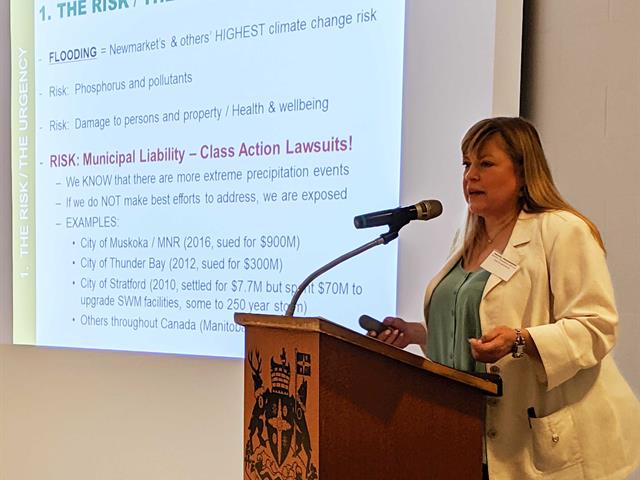
Absolutely! Newmarket looking at getting contractors to maintain some LID
That is one way to mitigate flooding effects, LEAF program – grants for trees in York Region
- Town of Newmarket – Site Alteration Bylaw – revised using guidelines from the LSRCA Stormwater Technical Working Group
- Forest Glen Road – Low Impact Development Demonstration Project – Town of Newmarket
- Town of Newmarket Council – Low Impact Development Workshop video – presentations by Jay Michels (Emmons and Olivier Resources), Mike Walters (LSRCA), Laura Zizzo (Mantle – Zizzo Strategy – specializes in Climate Change liability for municipalities) and Rachel Prudhomme (Town of Newmarket)
Presentation #5
The builder’s perspective - GERANIUM Corporation and SCS Consulting Group Inc.
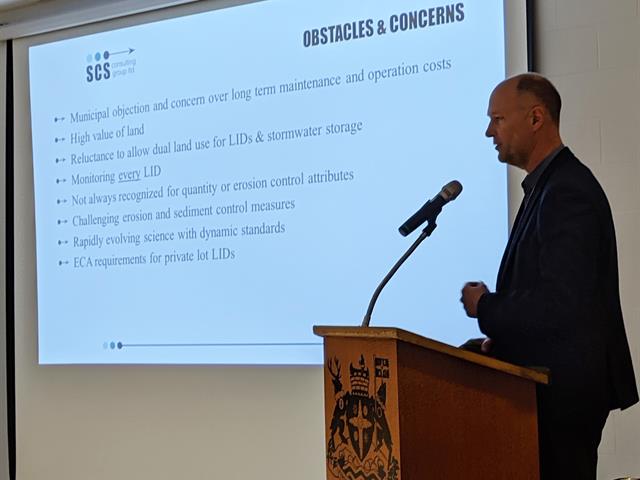
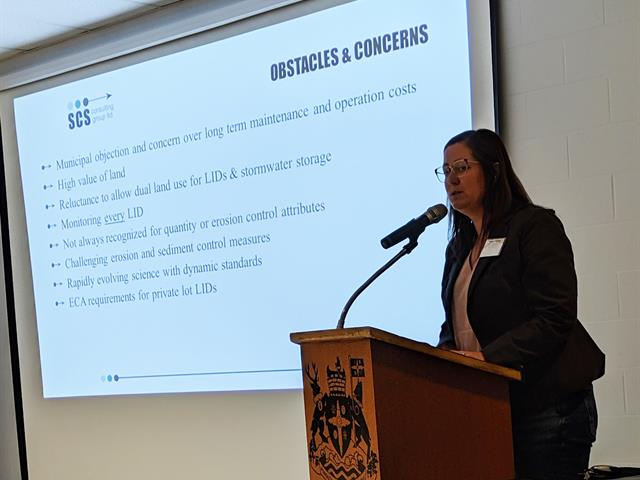
Volume reduction needs to be factored in with any models, reluctance to do that in the past; done through initial extraction
Key Messages:
- Developers want to promote and implement environmentally-friendly options like LID but may need help understanding alternatives, as well as how to do it
- Collaborative approach at the early stage is key to for optimal success
- obstacles and concerns
- maintenance cost, longevity
- high value of land (get more useable land using an LID approach, often have to have traditional SWMPs too)
- reluctance of dual land use (e.g., parks, schools)
- monitoring of every LID –necessary? -Sustainable Technologies Evaluation Program (STEP), concentrated effort
- quantity/erosion control benefit not always recognized
- construction stage has to protect LID from siltation (temporary sediment traps) –have to transfer knowledge/importance to builders
- rapidly evolving science, changing standards –keep new science public (STEP)
- lack of common goal, consistent approach from varying agencies
- ECA requirements from MECP at individual lot level –push for a “global” approach on ECAs at a municipal scale (LSRCA looking at this) to save time
- solutions:
- maximize dual land use
- share successes – STEP
- focused monitoring program, not every LID, identify key targets/metrics
- collaborative approach, conservation organizations, municipalities (e.g., LSRCA Rainscaping program)
- draft LID manual from MECP soon…
- ECA exemption for private lots
- developers mostly want to engage and deliver a good project
- in new developments, can do away with ponds by implementing treatment train approach of LID (e.g., Whole Foods, Markham centre)
- rain garden can be as simple as depressed grass area that the home owner cuts – doesn’t have to be fancy flower garden
- Friday Harbour – Rainscaping Program; first net zero P development in Ontario
Presentation #6
What Can Be Done: Experiences and Successes South of the Border - Jay Michels - E. and O. Resources
Key Messages:
- We need to go back to the way nature treats water – use of vegetation and soil
- Treat rain as close to source as possible and deal with the “first flush” (first 25 mm of rain) onsite LID is the perfect way
- Nonpoint Education for Municipal Officials (NEMO) Program – education program on stormwater in US
- wrote manual on LID design, WIKI based now so easy to update –office in Toronto now, work with CVC, LSRCA
- Green Streets manual
- natural landscape: 10% runoff
- development impacts on landscape: Tom Schueler (prominent SWM researcher): at 10% imperviousness start seeing impact, above 25% degradation occurs
- quantity impacts – lower summer base flow, spring flooding, flashiness
- quality impacts – non point source pollution, P loading, toxins, sediment, pathogens, debris, thermal stress
- current SWM practices not doing what they were intended to do, especially without proper maintenance
- traditional stormwater practice: convey, concentrate, centralize
- focus LID on first flush –rain events between 12-38mm are responsible for 75% of runoff pollutant discharge
- retain and restore –mimic natural processes to create a hydrologically functioning landscape
- “stacked benefits” e.g., LID under soccer field
- “knowing where to get water into the ground”
- Vancouver –capturing up to 48mm storm, water reuse
- backbone is bioretention –capture, filtration, infiltration, evapotranspiration –goal for a raingarden to drain in 48hrs – can get up to 98% sediment and P removal
- in heavier soils, sometimes need to add perforated pipes to speed up drainage
- still get high suspended sediment removal, 75-80% P removal
- in really heavy or contaminated soil, have to add liner and pipes, P removal down to 60%, still high suspended sediment removal
- case study – Crystal lake south of Minneapolis
- 17 rain gardens – accomplished 85% reduction in volume and associated pollutants
- tree trenches –Vancouver Olympic village
- mall retrofit –incorporate enhanced sand filters that uses iron filings to retain more P
- Lake Como –worked with landscape architect to do artistic renderings to show residents
- pre-treatment is critical, need way to trap sediment and be able to clean it out, oil/grit separators
- Capital region watershed district –has monitoring reports for Como Project and others
- rain garden performance improves over time as mature roots break soil apart
- relies on 2x per year clean out of pre-treatment infrastructure, leaf litter management
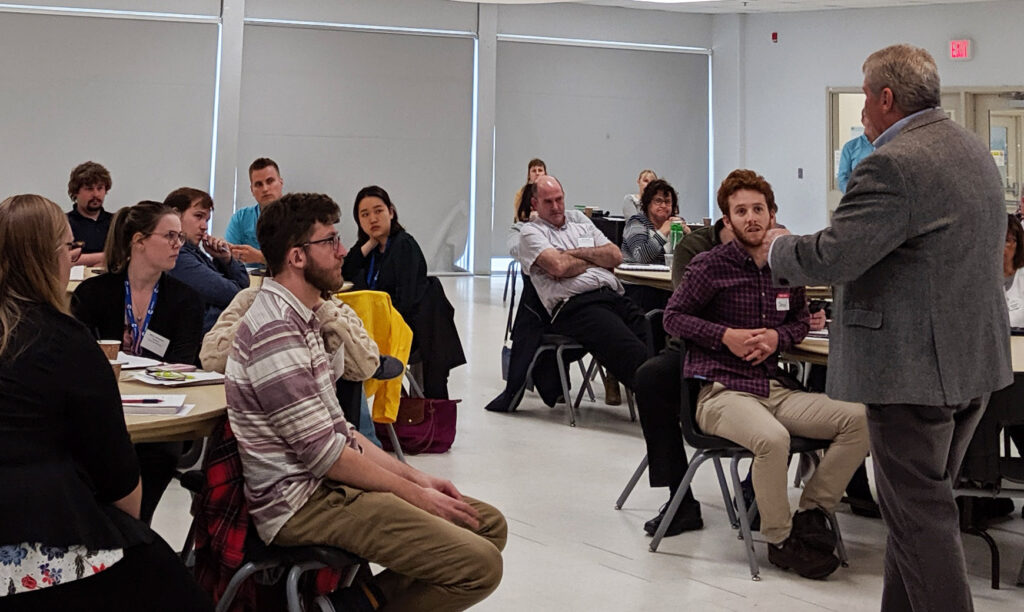
Have to decide based on site conditions, sun etc.
Use native plants, some bulbs for spring colour
-92% sand, 8% compost to start, garden creates its own nutrient pool
-first 2 years of maintenance are most intense
-don’t forget: wood chips float!
-lots of learning on effective, aesthetic plantings
-for one site, replaced soil medium after 22 years, that was before good pre-treatment

